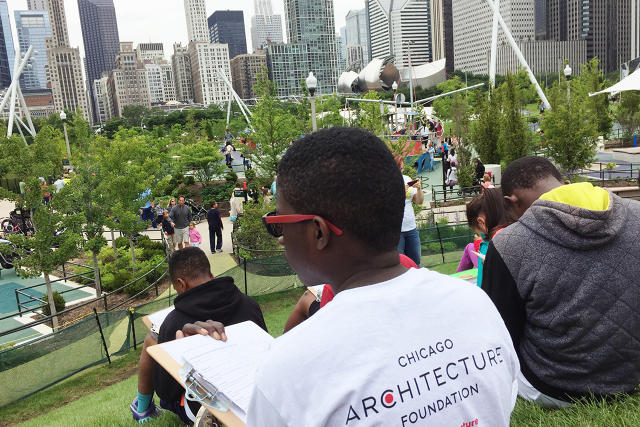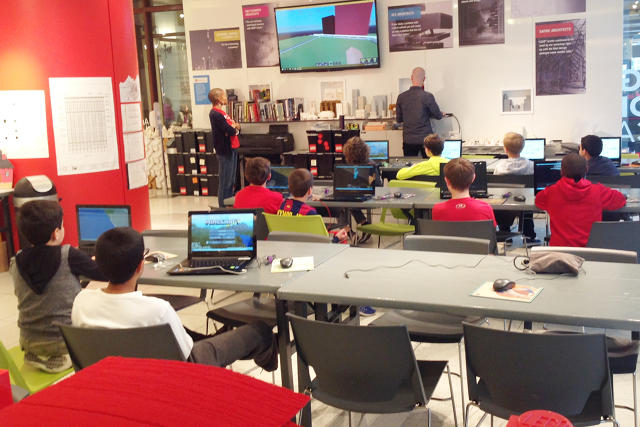Six-year-old Olive Sáenz has been “obsessed” with Minecraft for about a year, says her mother, Andrea Sáenz. “She spends hours building stuff, blowing stuff up, and building stuff again. She’s been pretty amazing at self-teaching.”
But until this past summer, the video game was a solo experience for Olive, who is just now learning to read. Because she wasn’t able to communicate with other players she instead spent hours watching Stampy Cat’s popular YouTube videos, which serve as a Minecraft “how to” for beginners, and putting her own spin on challenges like constructing a roller coaster.

Then, she went to Minecraft camp. At “Skyscrapers of Tomorrow,” a weeklong summer program developed by the Chicago Architecture Foundation, Olive worked on a team—dubbed the Unicorns—that used Minecraft to design a skyscraper that would function as a towering vertical neighborhood.
“It’s super fun because you can make whatever you want,” Olive says. “We even added a pink street.”
The last day of camp, when all the teams presented their skyscrapers to parents and teachers, was by far Olive’s favorite. “There was cookies! Everyone ate a cookie, I ate a brownie.”
“What I think she got out of the camp was the ability to observe how the world is built and organized, and then bring that back into Minecraft,” her mother says.

This fall Minecraft, the blockbuster game acquired by Microsoft for $2.5 billion in 2014, is moving into classrooms with an education-specific edition geared toward elementary school students. Microsoft, which is selling licenses between $1 and $5 per student, hopes to see teachers embrace the game as an entry point to lessons on computational thinking as well as traditional subjects like history, math, and science. To help teachers get started, the company has developed lesson plans around topics like the Temple of Artemis as a way to inspire creative applications for what is in many respects a remarkably free-form digital learning environment.
In the meantime, educational organizations including the Chicago Architecture Foundation have been at the forefront of developing curriculum around Minecraft, which even in its mainstream format lends itself to teaching and learning.
“The kids and parents love it,” says Gabrielle Lyon, vice president of education and experience for the foundation. “The parents are so relieved—they feel like, my kid is on Minecraft all the time, I don’t know if they’re learning anything. They come here and they feel great that their children are developing skills and getting to be social, but also doing things that take them outside.”

Students in the weeklong camp programs that the foundation introduced in August spend time at their computers, but also visit sites around Chicago in order to observe built environments with a critical eye and experience otherwise abstract architectural concepts, like pathways. On their first day, they measure the size of a Minecraft cube.
“Students leave with a real idea of scale and context,” Lyon says. “‘Read a building:’ we’re talking about materials, we’re talking about structures.”
So far, the foundation has introduced two variations on Minecraft camps, the skyscraper program and another called “Build a City” that emphasizes green space. Both run for five days, culminating in a 90-minute “showcase” that allows students to present their work. During the school year, the foundation plans to offer weekend workshops that use Minecraft to engage students in projects like repurposing historic buildings.
LEGOs and other physical blocks play a supporting role in the Minecraft programs, and a central role in other classes and workshops. Across all tools and mediums, Lyon says, the foundation’s focus on design and critical thinking remains intact. “The technology is a means to an end. Minecraft works best when it’s the best tool to get the job done.”
Chicago parent Jennifer Goolsby says she saw that philosophy come together in her son’s experience. “They don’t even realize they’re learning about arches and trusses and domes,” she says. “The hook is the technology.” Of course, the learning extends far beyond the redstone walls.
Forget Blueprints—For The Young Architects Of Tomorrow, It’s All About “Minecraft”